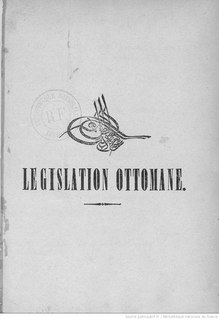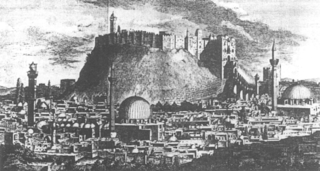
Conscription, sometimes called the draft, is the compulsory enlistment of people in a national service, most often a military service. Conscription dates back to antiquity and continues in some countries to the present day under various names. The modern system of near-universal national conscription for young men dates to the French Revolution in the 1790s, where it became the basis of a very large and powerful military. Most European nations later copied the system in peacetime, so that men at a certain age would serve 1–8 years on active duty and then transfer to the reserve force.

The Tanzimât was a period of reform in the Ottoman Empire that began in 1839 and ended with the First Constitutional Era in 1876.

Devshirme was the Ottoman Empire practice of recruiting soldiers and bureaucrats from among the children of their Balkan Christian subjects. Ottoman soldiers would take Christian boys, ages 8 to 20, away from their parents in Eastern and Southeastern Europe and removing them to Istanbul. The boys were then force-converted to Islam with the primary objective of selecting and training the best children and teenagers for the military or civil service of the empire, notably into the Janissaries.

The Gülhane Hatt-ı Şerif or Tanzimât Fermânı was a proclamation by Ottoman Sultan Abdülmecid I in 1839 that launched the Tanzimât period of reforms and reorganization in the Ottoman Empire. The 125th anniversary of the edict was depicted on a former Turkish postcard stamp.

Beginning from the late eighteenth century, the Ottoman Empire faced challenges defending itself against foreign invasion and occupation. In response to foreign threats, the empire initiated a period of tremendous internal reform which came to be known as the Tanzimat, which succeeded in significantly strengthening the Ottoman central state, despite the empire's precarious international position. Over the course of the nineteenth century, the Ottoman state became increasingly powerful and rationalized, exercising a greater degree of influence over its population than in any previous era. The process of reform and modernization in the empire began with the declaration of the Nizam-I Cedid during the reign of Sultan Selim III and was punctuated by several reform decrees, such as the Hatt-ı Şerif of Gülhane in 1839 and the Hatt-ı Hümayun in 1856. At the end of this period, marked with 1908, to a degree the Ottoman military became modernized and professionalized according to the model of Western European Armies. The period was followed by the defeat and dissolution of the Ottoman Empire (1908–1922).

Mehmed Fuad Pasha, sometimes known as Keçecizade Mehmed Fuad Pasha and commonly known as Fuad Pasha, was an Ottoman administrator and statesman, who is known for his prominent role in the Tanzimat reforms of the mid-19th-century Ottoman Empire, as well as his leadership during the 1860 Mount Lebanon civil war in Syria. He represented a modern Ottoman era, given his openness to European-style modernization as well as the reforms he helped to enact.
In the Ottoman Empire, a millet was an independent court of law pertaining to "personal law" under which a confessional community was allowed to rule itself under its own laws.

Mehmed Emin Âli Pasha, also spelled as Mehmed Emin Aali was a prominent Ottoman statesman during the Tanzimat period, best known as the architect of the Ottoman Reform Edict of 1856, and for his role in the Treaty of Paris (1856) that ended the Crimean War. Âli Pasha was widely regarded as a deft and able statesman, and often credited with preventing an early break-up of the empire.

The dissolution of the Ottoman Empire (1908–1922) began with the Second Constitutional Era with the Young Turk Revolution. It restored the Ottoman constitution of 1876 and brought in multi-party politics with a two stage electoral system under the Ottoman parliament. The constitution offered hope by freeing the empire's citizens to modernize the state's institutions and dissolve inter-communal tensions.

The Imperial Reform Edict was a February 18, 1856 edict of the Ottoman government and part of the Tanzimat reforms. The decree from Ottoman Sultan Abdulmejid I promised equality in education, government appointments, and administration of justice to all regardless of creed. The decree is often seen as a result of the influence of France and Britain, which assisted the Ottoman Empire against the Russians during the Crimean War (1853–1856) and the Treaty of Paris (1856) which ended the war.

Ottomanism was a concept which developed prior to the 1876-1878 First Constitutional Era of the Ottoman Empire. Its proponents believed that it could solve the social issues that the empire was facing.
Under the Ottoman Empire's millet system, Christians and Jews were considered dhimmi under Ottoman law in exchange for loyalty to the state and payment of the jizya tax.
Conscription in the Russian Empire was introduced by Peter I of Russia. The system was called "conscript obligation".

Military conscription in the Ottoman Empire varied in the periods of:
The Albanian Revolt of 1847 was a 19th-century uprising in southern Albania directed against Ottoman Tanzimat reforms which started in 1839 and were gradually being put in action in the regions of Albania.
Taxation in the Ottoman Empire changed drastically over time, and was a complex patchwork of different taxes, exemptions, and local customs.

The Aleppo Massacre, often referred to simply as The Events, was a riot perpetrated by Muslim residents of Aleppo, largely from the eastern quarters of the city, against Christian residents, largely located in the northern suburbs of Judayde (Jdeideh) and Salibeh. The riot began on the evening of October 17, 1850, and ended two days later on October 19, 1850. The riot resulted in numerous deaths, including that of the Syriac Catholic Patriarch Peter VII Jarweh.
The Ottoman Empire was governed by different sets of laws during its existence. The Kanun, a secular legal system, co-existed with religious law or Hanafi school of Islamic jurisprudence. Legal administration in the Ottoman Empire was part of a larger scheme of balancing central and local authority. Ottoman power revolved crucially around the administration of the rights to land, which gave a space for the local authority develop the needs of the local millet. The jurisdictional complexity of the Ottoman Empire was aimed to permit the integration of culturally and religiously different groups.
The Ottoman army was the military structure established by Mehmed II, during his reorganization of the state and the military. This was the major reorganization following Orhan I's standing army paid by salary rather than booty or fiefs. This army was the force during the rise of the Ottoman Empire. The organization was twofold, central (Kapıkulu) and peripheral (Eyalet). This army was forced to disbandment by Sultan Mahmud II on 15 June 1826 by what is known as Auspicious Incident following a century long reform efforts.
The martolos was an internal security force of the Ottoman Empire in the Balkans (Rumelia), mostly active between the 15th to 17th centuries. It initially constituted out of the local mostly Christian populations, but over time members converted into Islam. For their military service, they were given privileged status, in relation to the Rayah. Their commanders were predominantly Muslim.







